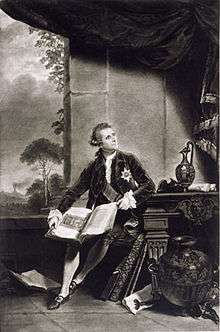1730s in archaeology
The decade of the 1730s in archaeology involved some significant events.
| Table of years in archaeology |
|---|
|
| Related time period or subjects |
| Art Archaeology Architecture Literature Music Science more In Template:Year nav topic: extra parameters: science |
Explorations
Excavations
- Formal excavations continue at Pompeii.
Finds
- 1738: First formal excavations of Herculaneum, sponsored by Charles III of Spain[1]

1730: William Hamilton.
Publications
- 1732: John Horsley - Britannia Romana (posthumous).
- 1735: Prospero Alpini - Historiæ Ægypti Naturalis (posthumous).
- 1736: Francis Drake - Eboracum (Roman York)[2]
Other events
- 1731: December 8 - Antiquarian John Freeman buries a 'time capsule' in the grounds of his house at Fawley Court in England.
- 1734: November 12 - Nicholas Mahudel reads a paper to the Académie des inscriptions et belles-lettres on Three Successive Ages of Stone, Bronze, and Iron, introducing the concept of the Stone, Bronze and Iron Ages.[3]
Births
- 1730: September 16 - William Hamilton, Scottish diplomat, antiquarian, archaeologist and volcanologist (d. 1803)
- 1732: Luigi Lanzi, Italian archaeologist (d. 1810)[4]
- 1735: August 8 - Jérémie Jacques Oberlin, Alsatian archaeologist (d. 1806)
Deaths
gollark: Some may now be safe as this uses seemingly all available computational power.
gollark: I *am* compiling Rust code. NONE are safe.
gollark: That seems like a great way to convince people that you haven't broken the law, yes.
gollark: ... no.
gollark: Again. In Rust. With 102947194129846 feature. And also -124081748917248978 feature.
References
- "Herculaneum - ancient city, Italy". Encyclopedia Britannica. Retrieved 17 January 2018.
- "York's first historian: Francis Drake: History of York". www.historyofyork.org.uk. Retrieved 17 January 2018.
- Hamy, M. E. T. (March–April 1906). "Matériaux pour servir à l'histoire de l'archéologie préhistorique". Revue Archéologique. 4e série. 7: 239–259.
- "Lanzi, Luigi". arthistorians.info. Retrieved 17 May 2017.
| Preceded by 1720s in archaeology |
Archaeology timeline 1730s |
Succeeded by 1740s in archaeology |
This article is issued from Wikipedia. The text is licensed under Creative Commons - Attribution - Sharealike. Additional terms may apply for the media files.